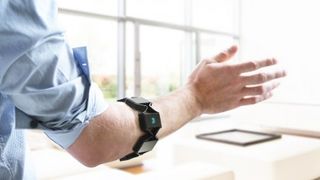Will gesture and VR soon be the primary methods of controlling our tech?
Control with a wave, swipe and pinch

The way we control the technology we use has been changing over the last few years. Where the keyboard and mouse have reigned supreme for decades, today gesture is becoming the new user interface. It's now possible to take full and precise control over computers and other devices to deliver an environment where control moves into the space around each device.
Gesture control has been developing for some time. The device that moved this technology away from something Tom Cruise would use and into the hands of mere mortals was Kinect from Microsoft. Beginning as a game peripheral, today the device is impacting many industries from healthcare to design. A good example here is Übi that can make any surface interactive.
One of the most well developed consumer products that places gesture and touch as the primary means of controlling applications is the HP Sprout. As the first product in what the company calls its Blended Reality range, the idea is to integrate the real 3D world we live in and understand with digital tools that enable us to manipulate virtual objects that will eventually then turn back into physical artefacts thanks to advanced 3D printing technologies.
Also, Intel has been working on its own 3D technology it calls RealSense. The 3D cameras offer a means of capturing depth, which can be used for a wide range of techniques from gaming to 3D mapping, and of course if the cameras can perceive depth, they would also be ideal as a platform for gesture control.

Wave to control
We've seen some rapid advances over the last few years when it comes to ditching the need to use a keyboard and mouse to control your desktop PC. Developments including Leap Motion which is a tiny sensor that plugs into a Mac or Windows PC to give you complete gesture control. The controller is also highly sensitive in that it can accurately track all of your fingers to 1/100th of a millimetre, which in practice allows fine control over painting and drawing applications for instance.
Already this standalone technology is finding its way into devices. First out of the gate is HP with the Envy 17 Leap Motion SE Notebook. The built-in Leap Motion sensor allows you to control a range of applications with nothing more than a gesture. And Leap Motion has moved its technology on again linking the device to the burgeoning VR market. Strap a Leap Motion to the front of your Oculus Rift, and you can have an immersive interactive experience.
Augmenting our bodies so they can control our technology is also a vibrant area of development. The Myo is an armband from Thalmic Labs, weighing just 93 grams, and it's rechargeable and expandable to accommodate even the thickest of forearms. Compatible with the leading operating systems, Myo can also be used in association with your smartphone or tablet using Bluetooth to make the connections needed.
Are you a pro? Subscribe to our newsletter
Sign up to the TechRadar Pro newsletter to get all the top news, opinion, features and guidance your business needs to succeed!
Offering nine-axis control, if you do fancy stepping into Minority Report, this is the closest you can get with current technology. Fuffr also offers a fast and convenient way to add gesture control to your phone. For communal gaming on the move it's a great gadget.
